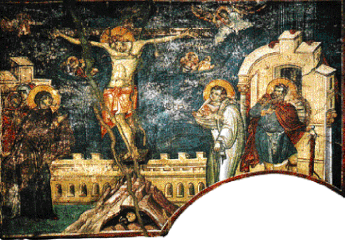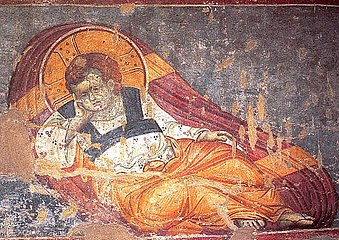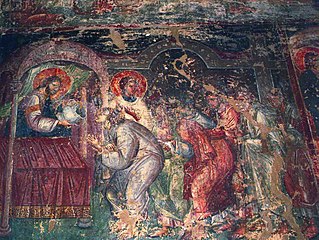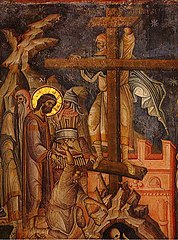art.wikisort.org - Artist
Manuel Panselinos (Greek: Μανουήλ Πανσέληνος) was a Greek fresco and icon painter in the late Byzantine Empire. He was active in the region of Macedonia, and is the most prominent figure of the Palaiologan Renaissance and the Macedonian School of painting, centred at the Empire's second city, Thessaloniki.[1]
Manuel Panselinos | |
|---|---|
 Jesus | |
| Born | late 13th century Thessaloniki |
| Died | early 14th century Thessaloniki |
| Nationality | Greek |
| Known for | Iconography and hagiography |
| Movement | Macedonian School |
History
Manuel Panselinos was born in the late 13th century in Thessaloniki. His primary works were iconography and frescos. His works can be found in several monasteries of Mount Athos: Vatopedi, Megisti Lavra, and the Protaton Church in Karyes. His most important work is the mural painting of the church of the Protaton. His contemporaries were Georgios Kalliergis, Michael Astrapas, and Eutychios Astrapas. Some historians believe Kalliergis was one of his students due to the similarity in painting styles.[2]
However, the tradition ascribing the Athonite paintings to Panselinos dates only from the 17th century, and it is only in the 18th century that Dionysios of Fourna claimed that he was born in Thessaloniki, and to have derived some of the rules in his own work from him.[3] Panselinos has sometimes been tentatively equated with Michael Astrapas or another member of the same family, but without firm evidence.[3]
Gallery
- Jesus as a child, Protaton, Karyes
- John the Baptist, Protaton, Karyes
- Jesus and Samaritan woman, Protaton, Karyes
- Presentation of Mary, Protaton, Karyes
- Saint Demetrius, Protaton, Karyes
- Saint Eustace, Protaton, Karyes
- Fresco from Saint Euthymius chapel, Thessaloniki
- Saint John the Evangelist, Protaton, Karyes
- Saints Mercurius and Artemius of Antioch, Protaton, Karyes
- Saints Theodore Stratelates and Theodore Tyron, Protaton, Karyes
- Resurrection of Christ, Protaton, Karyes
 Crucifixion of Jesus, Protaton, Karyes
Crucifixion of Jesus, Protaton, Karyes- Jesus and the Cross, Protaton, Karyes
See also
References
- Tsigaridas, Euth. N. (2003). Manuel Panselinos from the Holy Church of the Protaton. Athens, Greece: Hagioritiki Estia. p. 5.
- Alin, Trifa Razvan (March 2011). "MASTER MANUIL PANSELINOS AND THE MACEDONIAN SCHOOL OF PAINTING" (PDF). European Journal of Science and Theology. 7 (1): 13–23 – via European Journal of Science and Theology website.
- Cutler, Anthony (1991). "Panselinos, Manuel". In Kazhdan, Alexander (ed.). The Oxford Dictionary of Byzantium. Oxford and New York: Oxford University Press. p. 1572. ISBN 0-19-504652-8.
На других языках
- [en] Manuel Panselinos
[es] Manuel Panselinos
Manuel Panselinos o Panselenos (Μανουήλ Πανσέληνος) fue un pintor griego de finales del siglo XIII y comienzos del siglo XIV, uno de los más importantes artistas bizantinos tardíos, y uno de los principales creadores de la iconografía religiosa del cristianismo oriental. Se le considera la cumbre de la escuela macedónica, denominada en ocasiones como escuela de Panselinos (1290-1320).[1][it] Manuel Panselinos
Manuel Panselinos o Panselenos (in greco Μανουήλ Πανσέληνος; Salonicco, XIII secolo – XIV secolo) è stato un pittore bizantino, uno dei più importanti artisti bizantini e uno dei principali creatori dell'iconografia religiosa del cristianesimo orientale.[ru] Мануил Панселин
Ману́ил Пансе́лин (греч. Μανουήλ Πανσέληνος; конец XIII — начало XIV веков) — византийский живописец, иконописец Палеологовского периода.Другой контент может иметь иную лицензию. Перед использованием материалов сайта WikiSort.org внимательно изучите правила лицензирования конкретных элементов наполнения сайта.
WikiSort.org - проект по пересортировке и дополнению контента Википедии












